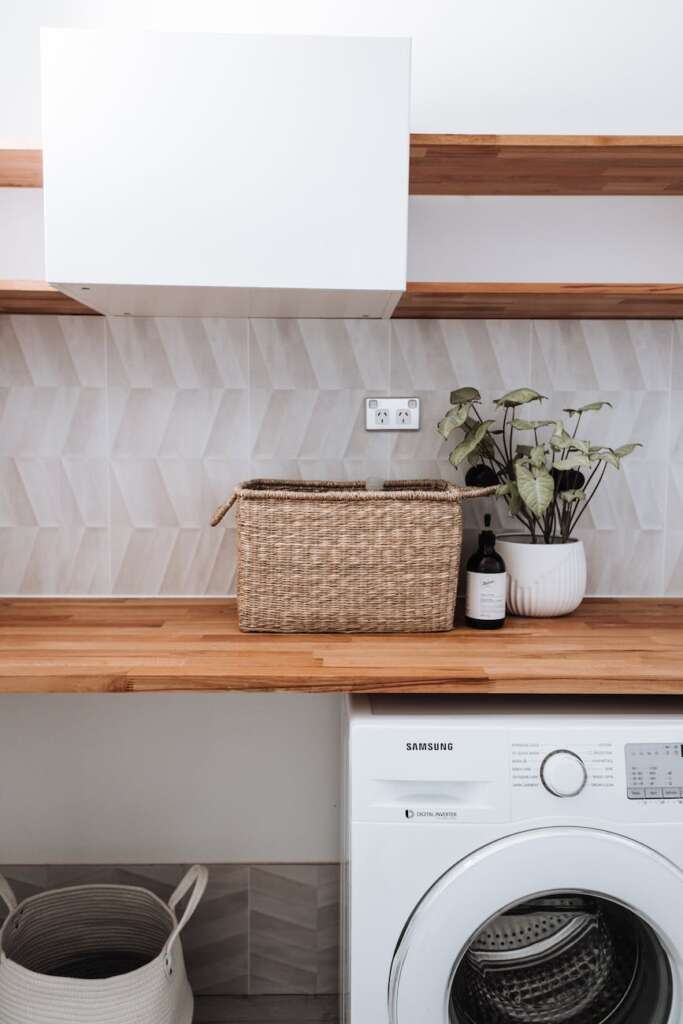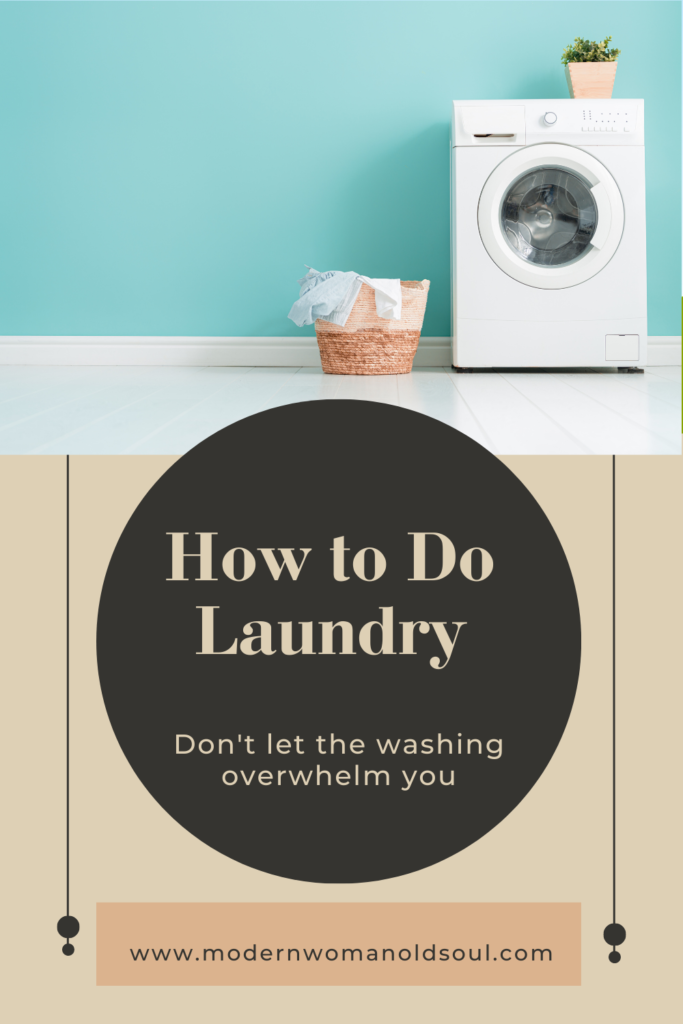
If laundry is taking over your life, have a look at my hints and tips on how to laundry, as well my washing schedule. It’s time to get your clothes clean, fresh and back in the wardrobe!
Some people hate laundry but I really don’t mind it and that’s because I have a system. If you’re responsible in your family for the bulk of the washing, drying and ironing, it’s important to keep on top of it so that the washing doesn’t overwhelm you.
My daughter was in reusable nappies for 18 months and although there were times when it felt endless, I loved seeing those fluffy white pieces drying in the sunshine.
Here I explain how I separate my washing, some tips and tricks to get the best from your laundry routine and how to fit family laundry into your day to day schedule without drowning under a pile of clothes!
How I separate my laundry
Do I really need to divide washing into different loads? Yes! And here’s why.
Delicates/wools: many garments in this category will recommend hand washing on the label. I no longer wash many things traditionally by hand, instead I find that the appropriate wash on my machine does the job. If you use too hot a wash or a wash with too high/too much spin, you can damage or even ruin delicates and wool items. This includes silk, wool, lace, fine manmade fibres, items with a lot of embellishments (sequins, beads etc) and lingerie with underwires. Given that most of these items can be expensive and you may not have many of them, laundering them correctly will help prolong their life and keep them looking, feeling and fitting their best. My favourite delicates laundry products are from Ecover. I also like using the cashmere and laundry sprays from The Laundress, but at the moment I can’t seem to get hold of them here in the UK.
Sportswear: I like to wash sportswear separately to other things because it gets pretty smelly and it’s usually synthetic so a long hot cotton wash is neither necessary nor appropriate. I like to throw some white vinegar in the drum with sports clothing to help banish sweaty smells!
Whites: if you wash your whites with non-whites, at best they will end up a murky grey colour, and at worst, the might end up another colour entirely if the dye from another item runs. I don’t use bleach, but white clothes can take more in terms of pre-wash stain treatments as the colour won’t fade and your machine may even have a specific whites wash load.
Lights: As with whites, keep all brights and darks separate. If an item is mainly light with an element of a brighter colour on, I will usually wash this with lights as if the colour were to run it would also run onto the lighter part of the same item, so it’s probably safe to assume it’s colour fast. If you’re worried though, you can try washing it by hand once, or with a colour fast/collector sheet to check.
Bright colours: I wash my bright colours together to stop their colours running into lighter fabrics. Some fabrics are more likely to run than others so even when something has been washed many times, it’s still a good idea to keep it separate from lights and whites.
Dark colours: I separate navy, black and dark grey and wash most jeans in a dark wash. If you have pale or light wash jeans, it should be ok to wash them with other pale colours. There’s much debate about how often denim should be washed, but my jeans get dirty through toddler playtimes, muddy gardening sessions and general life, so wearing them for months with the odd time-out in the freezer to kill off any bugs just isn’t for me!
Sheets and towels: I am gradually transitioning all sheets and towels to white so that they can all be washed together, with stain remover if necessary. This is a great way to minimise wash loads, especially if you have a machine with a large drum capacity (8+kg). If you have only a few items of white clothing you can then wash these with sheets and towels to make the load more efficient.
Tea towels and cleaning cloths: I do a load of these once a week with my daughter’s bibs. I put them on a hot wash, 40 or higher, to kill any germs. If you have towels and bedding that are not white, you could add tea towels and cleaning clothes to these instead if they are similar colours, to minimise the number of loads you need to do.
Drying your laundry
Line drying: I love to line dry! Preferably out in the garden on my rotary airer but if it is too damp outside then my next favourite option is to dry on an airer in front of the Everhot, or on a ceiling mounted pulley airer. These are fantastic space savers and really help maximise your space for drying indoors. Try to hang them somewhere with good ventilation so that condensation and dampness doesn’t build up: this isn’t good for the room or for the clothes, which might end up smelling musty.
Tumble drying: I don’t have a tumble dryer. For some of you that will come as a shock, but in the UK it is not as common to have a tumble dryer as it is in other parts of the world, particularly the US, partly because our homes tend to be smaller. If you do have a tumble dryer, my recommendation is that you use it only for cotton sheets and towels. This will help save valuable drying space on any airers you have and will also help keep them soft. Other items, especially those with high stretch content, embellishments or made from natural fibres, may be ruined in a tumble dryer so it’s just not worth it. Items that can technically be tumble dried will probably still deteriorate quicker than those that are line dried but this may be a trade-off you are happy to make.

Laundry tips
Sun: lights, whites and anything that gets sweaty (like sports clothing) will benefit from drying in the sunshine, even in Winter. Drying in the sun helps remove stains and smells from clothing, even after they’ve been washed. Heavy knits and wool or delicate items can also be hung out to air between washes to freshen them; this is a great way of prolonging the life of these items as well as reducing your laundry loads.
Remove stains promptly: if an item has been stained, treat the stain promptly with an appropriate stain remover before washing it. Different stains need different treatments but I have been delighted by the success I’ve had on removing grease stains from cooking or little toddler hands using washing up liquid! A little washing up liquid squeezed onto the stain, rubbed in and left for 10 minutes or so, and then into the correct wash load has really worked a treat.
Don’t leave wet laundry: Don’t leave your laundry sitting in the machine or the basket for too long, if you do, it will likely smell musty and unclean when it dries and you will have to go through the whole process again. I like to wash overnight to hang out in the morning, and then put a wash on in the morning ready to hang out in the afternoon or evening.
Find a good place to dry: If or when you can’t dry your clothes outside, drying your clothes in a room with space, light and ventilation is the next best thing. Don’t dry your clothes in the kitchen while cooking or they will likely absorb some of the cooking smells.
Ironing: it’s personal choice but I love to iron, my clothing looks and fits better and it helps me feel more put together even if I’m wearing a casual outfit. I don’t iron towels or undergarments but occasionally give my bedding or tea towels a quick press if I have time (which isn’t often!)
Want to do laundry the Modern Woman Old Soul way? Download my free laundry printable plan.
This post contains affiliate links. If you purchase something via a link, I may be paid a small sum, but it doesn’t cost you anything extra. I will only ever recommend products I use, or would use, and give my honest opinion of a product or service regardless of any commercial interest.
I LOVE to do laundry too!!!! I like to listen to podcasts when I hang my washing up.
There are so many chores you can combine with something you love, it’s a great way to feel productive and get back some ‘me time’. x